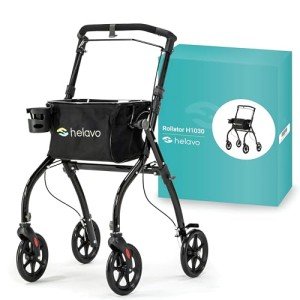How Non-Slip Walker Changed My Life For The Better

The Benefits of Non-Slip Walkers: Enhancing Mobility and Safety for All
As we browse through the varied landscape of mobility aids, one vital product sticks out: the non-slip walker. This important tool not just help those with limited mobility however also promotes self-reliance and security. In this article, we will delve into the benefits of non-slip walkers, the numerous types available, and what features to look for when choosing the best walker. Along the method, we will answer frequently asked concerns and supply insights that enhance understanding of this important mobility accessory.
Why Choose a Non-Slip Walker?
Non-slip walkers are particularly created with security in mind. Indoor Walker and falls can trigger major injuries, especially for elderly people or those recuperating from surgery. Integrating anti-slip features into a walker can drastically decrease the danger of mishaps, making it an important option for anyone in need of assistance. Here are a couple of reasons a non-slip walker is a worthy financial investment:
- Enhanced Stability: Non-slip grips and rubberized wheels offer remarkable traction on various surfaces.
- Improved Safety: The design lessens the likelihood of slips, providing users confidence as they move.
- Increased Independence: Those who might have formerly relied on caregivers can regain some degree of autonomy.
- Versatile Design: Non-slip walkers can be tailored to fit a series of individual needs and preferences.
Kinds Of Non-Slip Walkers
Non-slip walkers can be found in numerous designs, each tailored to accommodate various mobility needs. Below is a contrast table highlighting the most typical types of non-slip walkers readily available:
| Type of Walker | Features | Suitable For | Cost Range |
|---|---|---|---|
| Standard Walker | Four legs, lightweight, rubber ideas | General use, moderate assistance | ₤ 50 - ₤ 100 |
| Two-Wheeled Walker | 2 front wheels, two rear legs with rubber ideas | People who need assistance but can stroll | ₤ 70 - ₤ 150 |
| Rollator | Four wheels, braking system, seat option | Active people; provides a rest alternative | ₤ 100 - ₤ 250 |
| Knee Walker | Created for individuals with knee injuries | Short-term healing from leg or foot injuries | ₤ 80 - ₤ 200 |
| Pediatric Walker | Smaller sized size, colorful styles | Kids with mobility concerns | ₤ 60 - ₤ 120 |
Aspects to Consider When Choosing a Non-Slip Walker
Selecting the best non-slip walker can be a frustrating job. Here are some factors to remember when deciding:
- User's Weight and Height: Ensure that the walker supports the user's weight and matches their height.
- Kind of Surface: Consider where the walker will be mainly utilized (inside vs. outdoors) to pick a suitable tire configuration.
- Portability and Weight: If the walker requires to be transported, consider weight and foldability for convenience.
- Adjustability: Look for a walker that can be changed to the user's particular height requirements, guaranteeing comfort and safety.
- Additional Features: Some walkers consist of features such as built-in seats, storage baskets, or more advanced braking systems.
Additional Features of Non-Slip Walkers
While taking a look at non-slip walkers, several extra features can boost user experience:
- Ergonomic Grip Handles: Soft and comfortable grips can lower stress on the hands.
- Reflective Materials: Adding increased visibility can help those who might be using the walker in low-light conditions.
- Customizable Accessories: Consider alternatives like cup holders, trays, or perhaps oxygen tank holders for included convenience.
- Resilience: Look for walkers built from high-quality products to make sure long-lasting use.
Often Asked Questions (FAQs)
1. What is the main distinction in between a basic walker and a rollator?
- A standard walker has four legs and requires the user to raise it with each step, whereas a rollator has wheels, permitting the user to push it along more quickly.
2. Are non-slip walkers ideal for outdoor use?
- Yes, lots of non-slip walkers are developed for different surfaces. It's important to select a design with ideal wheels for outdoor terrain.
3. Can a non-slip walker be used by individuals who have had hip or knee surgery?
- Definitely. Non-slip walkers supply stability and can be important for those recuperating from such surgeries.
4. How do I change the height of a walker?
- Many walkers include adjustable legs that allow you to alter the height. Refer to the manufacturer's guidelines for specific modification directions.
5. Is there a weight limit for non-slip walkers?
- Yes, each walker has a defined weight limitation. It is necessary to carefully inspect this information before buying to make sure safety.
6. Can I utilize a non-slip walker in shops or public places?
- Yes, non-slip walkers are developed for use in different environments. Simply make sure the design you choose is maneuverable enough for enclosed spaces.
Investing in a non-slip walker can supply users with enhanced mobility, self-confidence, and independence. The range of styles and features readily available enables users to choose a walker that best fits their unique needs. By considering aspects such as weight capability, adjustability, and extra features, one can ensure that they or their enjoyed ones are safe and comfortable.
For those looking for to restore their self-reliance, non-slip walkers not just aid in mobility but likewise add to a more active lifestyle. If you or someone you know might gain from a non-slip walker, put in the time to explore the choices offered-- your journey towards increased security and autonomy starts here!

